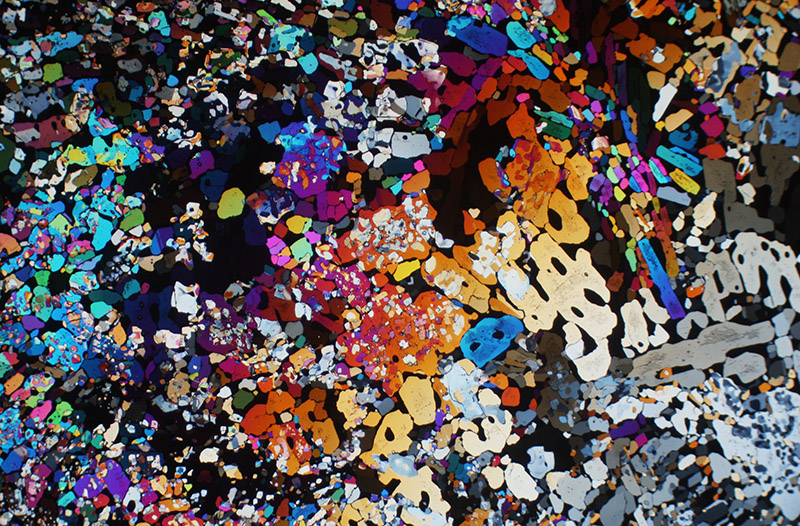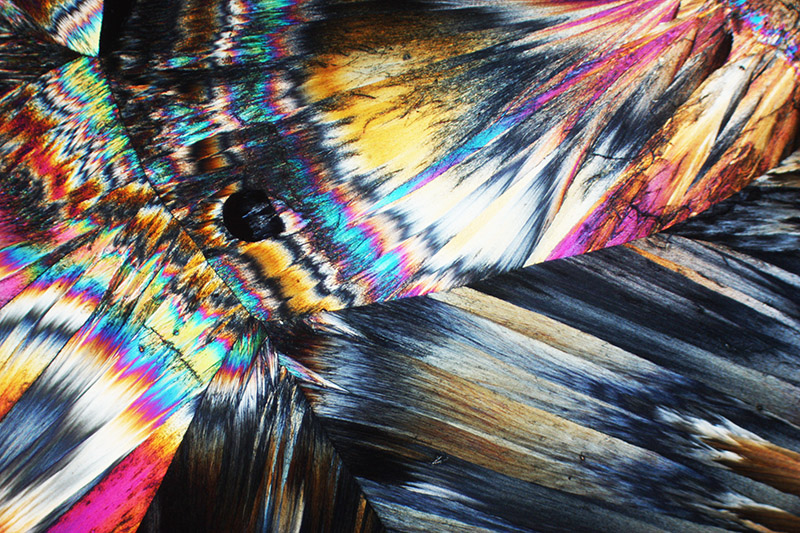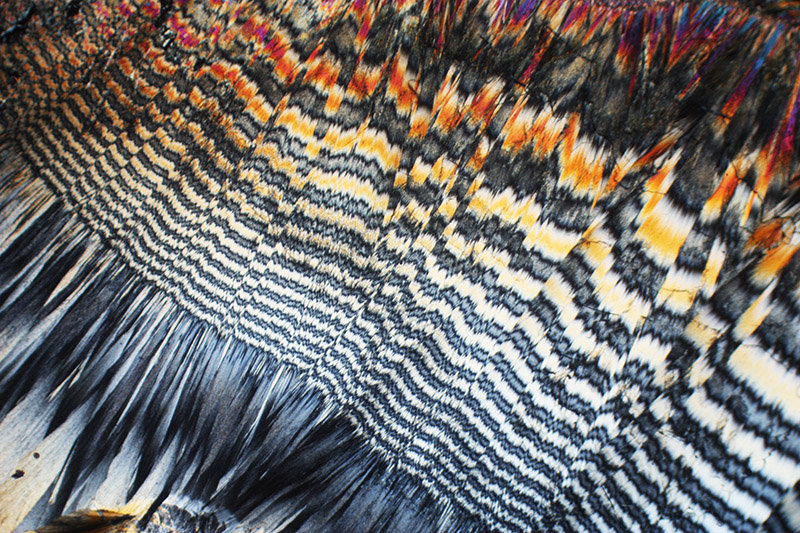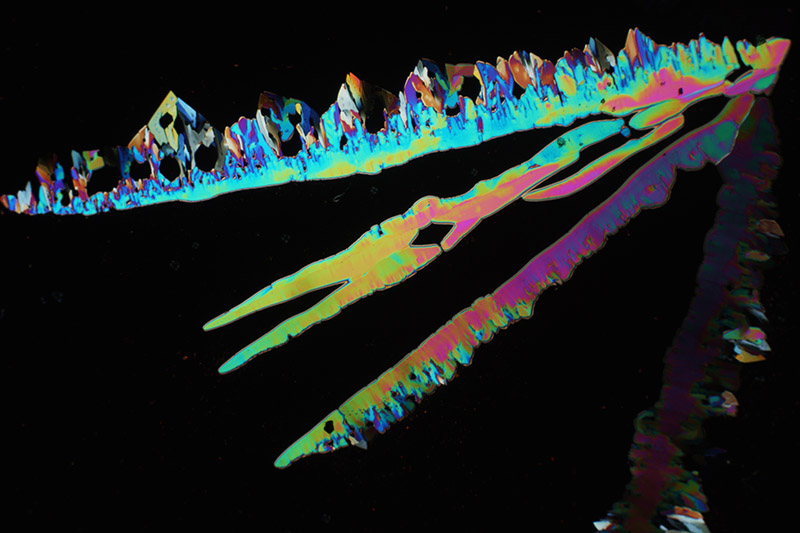Frederick George Wood, 1869 - 1947
by Brian Stevenson
last updated April, 2018
F.G. Wood produced microscope slides of various chemical crystals. Some of these were pure, but many were mixtures of two or more different chemicals. The compositions of the latter appear to have been secret, and were identified by codes of letters and numbers. Many of his slides still bear his red “Krystlmot” label.
Labels give Wood’s address as Marsden, Ashtead, Surrey (England). Wood moved to the Ashtead home he named “Marsden” in about 1914. He moved to another house in the nearby town of Epsom circa 1939. Records of his displaying chemical microscope slides have been located between 1916 and 1931, with use of the phrase “Krystlmot” in 1931.

Figure 1.
Microscope slides by F.G. Wood, all of which are chemical crystals. Two bear his “Krystlmot” label and Marsden, Ashtead, Surrey address. The three leftmost slides contain mixtures of different chemicals, while the right slide contains crystals of strontium platinocyanide. The letters “MX” presumably mean “mixture”. The specimen of “OC 526” appears to be a chemical(s) that was crystallized in an oily substance. All are intended for observation between crossed polarizing filters (see Figures 2-6, at the end of this essay).
Frederick Wood was born in Deptford, Kent. He was christened on September 28, 1869, and subsequent census indicate that his birth was within a few months of that date. Frederick was the fourth (and last) child, and second son of James Brasier Wood and Elizabeth Wood. The father was a storekeeper, with records indicating that he managed shops for corporations. Shortly after Frederick’s birth, the family moved to 32 Prince Street, London. The family appears to have been modestly middle class: there were no servants, mother Elizabeth worked as a “straw hat cleaner”, but all of the children were in school (including the eldest child, a daughter, aged 11). Father James died in late 1872, which undoubtedly changed the family’s economics.
The next identified census, of 1891, shows Frederick, his mother, and two sisters still living at 32 Prince St. Frederick, then 21, was listed as working as a “designer decoration glass work”. Later records imply that he drafted designs for decorating glasswork. It is possible that this occupation introduced him to colorful chemicals, and the creative results that might be obtained from mixtures and crystallization techniques.
Frederick married Ada Annie Lawrence on April 10, 1896. His occupation was listed as “draughtsman”. The couple had two children: Frederick Harold Victor in June, 1897, and Winifred Ethel Elizabeth in February, 1899. Frederick’s occupation was again recorded as “draughtsman” on both of their christening records. Wife Ada died during the summer of 1899. The proximity to Winifred’s birth suggests complications from that birth. Frederick remarried in late 1900, to Elizabeth Marie Conratin. The 1901 census shows Frederick, Elizabeth, and the two children at 92 Lyndhurst Road, in the Camberwell section of London. His occupation was listed as “glass / decorator”. Son George Eric Paul was born in 1902, in Camberwell.
Another son, Donald Ernest Louis, was born in 1907 in the Epsom district of Surrey. That year’s electorate list recorded Frederick as living at Reigate Villas, Leatherhead, Surrey (which is within the district of Epsom). The 1910 voter records show the same address.
By March, 1911, the Woods had moved to a house named “Whyteleaf”, on Maple Road, Ashtead. That year’s census listed Frederick’s occupation as an “horticultural sundries manufacturer”, and an “employer”. Related to that occupation, Wood made presentations to the Royal Horticultural Society in 1918 and 1921, and won an award in 1918 for his display of Statice incana. The family was still living at “Whyteleaf” in 1912, according to that year’s electoral register.
The 1914 electoral register shows that the woods had moved to “Marsden”, Barnett Wood Lane, Ashtead. This is the address he placed on his “Krystlmot” labels. Therefore, this is the earliest possible date for production of those labeled slides.
Wood was clearly excited about microscopy of chemical crystals by 1916. On April 10 of that year, the South London Entomological & Natural History Society hosted, “Mr. F.G. Wood, a visitor, showed a number of Chemical Crystals under Polarised Light, including Asparagine, Salacine, a series of Platino-cyanides, and Hippuric acid, many of them very beautiful in the colour and arrangement of their particles”. Such a presentation as a visitor suggests that Wood was advertising products for sale.
Wood thought of his chemical productions as more than just pretty things, but as inspirations for novel color shades and combinations. In 1930, he presented to the Textile Institute: “New Motives for Textile Designs - This meeting took the form of an address and a demonstration of crystallisations seen through the microscope by polarised light. The speaker was Mr. F.G. Wood, who said he was glad of an opportunity to show his work to a textile gathering. The beauties of crystallisation in some of its many forms had of course long been known, whilst through the microscope many people had become familiar with the less common crystals. His investigations had been directed not only towards a means of making these lovely forms and colours available to designers and others interested, but to enhance their value and beauty by the use of polarised light. He did not think crystal forms seen thus had been explored as a source of designs and colour schemes. He also pointed out that the slides exhibited were those of his own choice and might embody colour schemes not acceptable to all. In addition it was to he noted that it was difficult to provide a large audience with a projected image big enough for all to see and yet sufficiently defined to retain the delicate shades the smaller projections revealed. A smaller downward projection of 15 in. diameter was available for use after the lecture. The lecturer then showed three series of slides, the first being those of substances upon which he first began to work, then those of substances specially compounded by himself for this purpose and finally a series designed to exhibit the range of variation possible upon any chosen theme. After the demonstration Mr. Wood was cordially thanked for his services”. A similar presentation was made to the Royal Society of Arts in 1931.
The “smaller downward projection of 15 in. diameter” mentioned in the above report was probably Wood’s “Krystlmot Projector”, described to the Photomicrographic Society in 1931. Such a device would be ideal for one person or a small group to examine and discuss color combinations and patterns.
The 1938 voter registration list shows that Frederick, wife Elizabeth, and daughter Winifred were still living at “Marsden”. Son George and his wife lived a few doors away. The 1939 list indicates that Frederick and family had moved to 18 West Hill Avenue (also known as “The Mount”), Epsom, Surrey.
Frederick Wood died on August 3, 1947, aged 79. His wife, Elizabeth, died a week later.

Figure 2.
A section of “MX 54”. This and the following images were viewed between crossed polarizing filters (polariscope), with a 3.5x objective lens and a C-mounted digital SLR. Neither filters nor digital color alterations were employed.

Figure 3.
Another section of “MX 54”. A single slide might show multiple shapes and colors, due to Wood’s methods of mixing chemicals and crystallization conditions.

Figure 4.
A view of “MX 60”.

Figure 5.
Another view of “MX 60”.

Figure 6.
“O.C. 526”.
Resources
Bracegirdle, Brian (1998) Microscopical Mounts and Mounters, Quekett Microscopical Club, London, pages 104 and 150, plate 23-P
Christening record of Frederick George Wood (1869) Parish records of St. Nicholas Church, Deptford, accessed through ancestry.com
England census, electoral, birth, marriage, death, and other records, accessed through ancestry.com
Journal Of The Royal Horticultural Society (1919) “Floral Committee, August 13, 1918, Cultural Commendation: To Mr. F.G. Wood, Ashtead, for Statice incana”, Vol. 44
Journal Of The Royal Horticultural Society (1922) Scientific Committee, July 21, 1921: “Proliferation in Geum - Mr. Fraser showed on behalf of Mr. F.G. Wood abnormal flowers proliferating of Geum rivale, Leonard's variety”, Vol. 47
Journal of the Textile Institute (1931) New motives for textile designs, Vol. 22, page 9
Probate of the will of Elizabeth Marie Wood (1947) accessed through ancestry.com
Probate of the will of Frederick George Wood (1947) accessed through ancestry.com
Proceedings of the South London Entomological & Natural History Society (1916) “Mr. F.G. Wood, a visitor, showed a number of Chemical Crystals under Polarised Light, including Asparagine, Salacine, a series of Platino-cyanides, and Hippuric acid, many of them very beautiful in the colour and arrangement of their particles”, page 57
Wood, F.G. (1931) Demonstration by polarized light of new micro-crystallisation, Journal of The Royal Society of Arts, Vol. 29, page 358
Wood, F.G. (1931) Mr. Wood’s Krystlmot projector, Journal of The Photomicrographic Society, Issue 90, page 229





